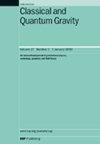Estimating false alarm rates of sub-dominant quasi-normal modes in GW190521
IF 3.6
3区 物理与天体物理
Q2 ASTRONOMY & ASTROPHYSICS
引用次数: 0
Abstract
A major aim of gravitational wave astronomy is to test observationally the Kerr nature of black holes. The strongest such test, with minimal additional assumptions, is provided by observations of multiple ringdown modes, also known as black hole spectroscopy. For the gravitational wave merger event GW190521, we have previously claimed the detection of two ringdown modes emitted by the remnant black hole. In this paper we provide further evidence for the detection of multiple ringdown modes from this event. We analyse the recovery of simulated gravitational wave signals designed to replicate the ringdown properties of GW190521. We quantify how often our detection statistic reports strong evidence for a sub-dominant ringdown mode, even when no such mode is present in the simulated signal. We find this only occurs with a probability ∼0.02, which is consistent with a Bayes factor of (1σ uncertainty) found for GW190521. We also quantify our agnostic analysis of GW190521, in which no relationship is assumed between ringdown modes, and find that only 1 in 250 simulated signals without a mode yields a result as significant as GW190521. Conversely, we verify that when simulated signals do have an observable mode they consistently yield a strong evidence and significant agnostic results. We also find that constraints on deviations from the mode on GW190521-like signals with a mode are consistent with what was obtained from our previous analysis of GW190521. Our results support our previous conclusion that the gravitational wave signal from GW190521 contains an observable sub-dominant mode.估算 GW190521 中次主导准正常模式的误报率
引力波天文学的一个主要目的是通过观测检验黑洞的克尔性质。对多重环落模式(也称为黑洞光谱学)的观测提供了最有力的检验,而且只需最少的额外假设。对于引力波合并事件 GW190521,我们之前声称探测到了残余黑洞发出的两种环落模式。在本文中,我们提供了从该事件中探测到多种环落模式的进一步证据。我们分析了为复制 GW190521 的环落特性而设计的模拟引力波信号的恢复情况。我们量化了我们的探测统计报告在多大程度上提供了次主导环落模式的有力证据,即使模拟信号中并不存在这种模式。我们发现这种情况发生的概率仅为 0.02,这与 GW190521 的贝叶斯系数(1σ不确定性)是一致的。我们还量化了对 GW190521 的不可知分析,其中假定环降模式之间没有关系,结果发现,在 250 个模拟信号中,只有 1 个没有模式的信号会产生与 GW190521 一样显著的结果。相反,我们验证了当模拟信号确实有一个可观测的模式时,它们始终会产生一个强有力的证据和重要的不可知论结果。我们还发现,对具有模式的 GW190521 类似信号的模式偏差的限制与我们之前对 GW190521 的分析结果是一致的。我们的结果支持我们之前的结论,即来自 GW190521 的引力波信号包含一个可观测的次主导模式。
本文章由计算机程序翻译,如有差异,请以英文原文为准。
求助全文
约1分钟内获得全文
求助全文
来源期刊

Classical and Quantum Gravity
物理-天文与天体物理
CiteScore
7.00
自引率
8.60%
发文量
301
审稿时长
2-4 weeks
期刊介绍:
Classical and Quantum Gravity is an established journal for physicists, mathematicians and cosmologists in the fields of gravitation and the theory of spacetime. The journal is now the acknowledged world leader in classical relativity and all areas of quantum gravity.
 求助内容:
求助内容: 应助结果提醒方式:
应助结果提醒方式:


